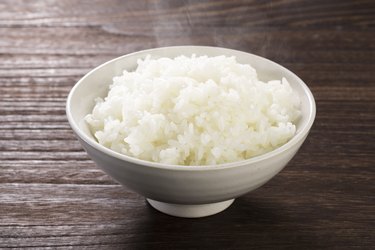
The simple steamed rice served at restaurants is usually boiled in a sealed pot or electric rice cooker. Novices tend to favor a rice cooker, which doesn't require as much supervision as a pot on the stovetop. If you don't have a rice cooker but do have an electric vegetable steamer, you can use that instead to prepare fluffy, perfectly cooked rice. Some appliance models even include a rice-cooking bowl to make cooking rice in a steamer easier.
Using a Rice Cooking Bowl
Video of the Day
Vegetable steamers have a mesh or grid-style bottom, which holds vegetables in place but lets hot steam pass freely. The openings in the mesh are usually large enough that rice would fall into your steamer's reservoir, so pouring rice in the steamer basket isn't an option.
Video of the Day
Many steamers include a rice-cooking bowl. The bowl is solid to hold the rice, but it's open at the top so hot steam cooks the rice like a sealed saucepan. To use this method, follow these steps:
- Measure rice and water into the steamer's rice bowl with a pinch of salt. Check the rice instructions. The usual measurement is two parts water to one part rice.
- Fill the steamer's reservoir to its maximum level, and assemble the steamer compartments and drip tray as usual. Position the rice bowl inside the steamer compartment, and cover it with the lid or another steamer compartment containing other foods.
- Set the timer to 45 or 50 minutes for brown or red rice, or 25 to 30 minutes for white rice. If your steamer has a specific push-button setting for cooking rice, use that instead.
- Open the steamer carefully, watching for hot steam that escapes, and test the rice. If it's not evenly cooked, replace the lid and leave it for another 5 to 10 minutes. Unlike the sealed-pot method, you can do this in a vegetable steamer without spoiling the rice.
- Remove the rice from the steamer once it's fully cooked, and let it rest for 5 to 10 minutes before fluffing it with a fork.
Cooking Rice in a Steamer Directly
You can also steam your rice directly in a steamer compartment. This method eliminates the question of how much liquid to use. The rice absorbs as much moisture as it needs from the steam while it cooks.
- Unroll cheesecloth and fold it, so it lines the compartment with three or four layers. Lift and dampen the cloth. Press it back into the steamer.
- Measure and pour the rice into the steamer compartment. Spread it around to make an even layer.
- Fill the reservoir to the maximum level. Set the timer and turn it on. Steam plain white rice for roughly 25 minutes, and brown or black rice for 45 minutes to an hour, or until it's tender.
- Lift the cooked rice, using the corners of the cheesecloth as a handle. Tip it into a serving bowl. Cover loosely and let it rest for 5 to 10 minutes before serving.
If you don't have an electric steamer, you can use a metal or Chinese bamboo steamer using the same technique. Keep the water level below the steamer and use a tight-fitting lid for the pot or steamer basket.
Finessing the Rice
You can improve your direct-steamed rice by following a few expert tips.
- For extra-fluffy rice, rinse before you cook. Friction between the grains in the bag creates a layer of rice flour that coats the grains and becomes sticky while cooking. Skip this step for rice in steamer recipes like sweet or "sticky" rice, which is supposed to cling.
- Asian sticky rice and black "forbidden" rice steam faster if they're soaked ahead of time, for at least a few hours and ideally 8 or more. Basmati doesn't need soaking to speed its cooking, but it's longer, lighter and fluffier if it's soaked for at least an hour.
- Don't fluff rice until it rests. When freshly cooked, the starches in the rice are still soft and slightly gelatinous, like those in fresh-baked bread. If you fluff it at this point, you'll make a sticky mess. After a few minutes of cooling, those starches re-crystallize, and the rice is firm enough to retain its shape.